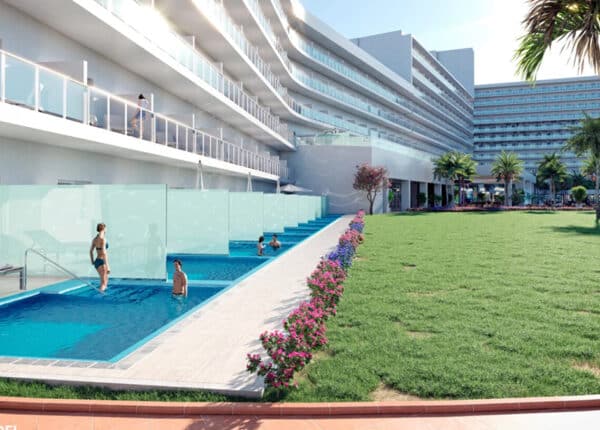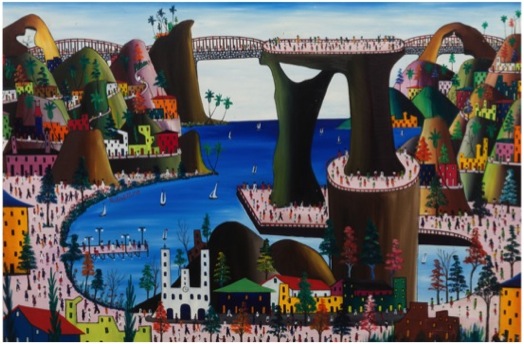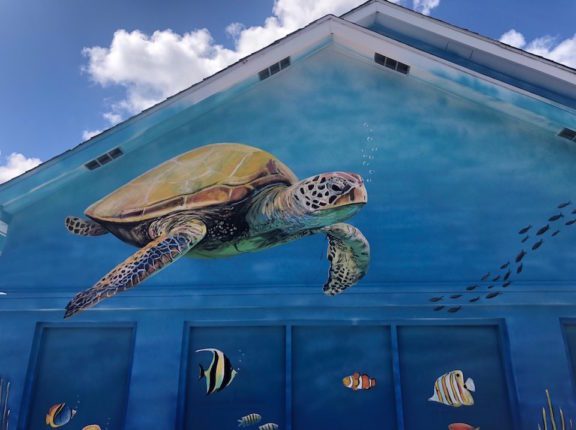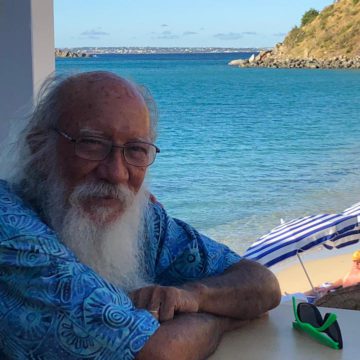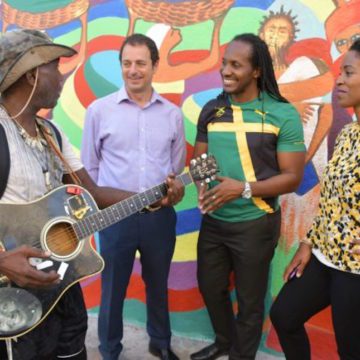At New York’s El Museo del Barrio, Caribbean Art in the Spotlight
Above: Prefete Duffaut, Habour/Vue de Jacmel avec le Pont de Noel, 1968, oil on canvas (Photo by Jason Mandella)
By Alexander Britell
Beginning Jun. 12, New York’s El Museo del Barrio will put Caribbean art in the spotlight, with Caribbean: Crossroads of the World, a sweeping look at the history of Caribbean art, beginning with the Haitian revolution. In December, El Museo opened Voces Y Visiones: Gran Caribe, which shows some of the Caribbean work in the museum’s permanent collection, in order to introduce some of the major themes of Crossroads – from the ubiquity of water in Caribbean art to the role of spirituality. To learn more, CJ Arts talked to curator Rocio Aranda-Alvarado about the role of the Caribbean diaspora in American art and the growing awareness of Caribbean works.
Talk about Voces y Visiones: Gran Caribe.
We’ve been working on a larger Caribbean project for several years, since before 2006, because we wanted to do a large Caribbean exhibition. We really thought it would be something that would look at the history of the Caribbean, starting with the Haitian revolution and going through the 20th century. We partnered with the Studio Museum in Harlem and also the Queens Museum on something called Caribbean: Crossroads of the World, which opens in June of this year. So that’s how it came about. For Gran Caribe, I chose some of the themes that will be addressed in this larger show, and selected works from our collection that reflect those themes.
Above: Emilio Sanchez, Untitled, Le Select Restaurant, St Bart’s, 1970s, oil on canvas (Photo by Jason Mandella)
What are the major themes in the exhibition?
When you first walk in , the first exhibition deals with religion and spirituality. For example, there are a variety of works, a couple of small works by a Haitian painter, both from the early 1970s, with two small paintings and two images of different events that take place in a church. One looks like a first communion, and the other appears to be a wedding. And then we incorporated different kinds of masks – some from Guatemala, some from Puerto Rico, that are used in Carnival celebrations. So we thought about religion and spirituality in a broad way, and looked at the different ways it’s celebrated throughout the Caribbean. We were not only looking at the different belief systems, but also how religion, as a whole, has influenced the culture of the Caribbean.
What are some of the other themes addressed?
When you turn the corner, another section explores a human figure and the urban environment. It includes a series of black and white photographs taken around New York City and New York State in the early 1970s by a group of photographers who wanted to make a portfolio about Puerto Rican life in New York, and specifically focus on education and small business, and on the image of labour. These are really beautiful original prints from the 70s. The next addresses abstraction and abstraction as a language that’s been used by artists throughout the Caribbean, for different themes. So there’s a section just on abstract sculpture with works by various Puerto Rican artists including Papo Colo, Marco Dimas, Charles Juhasz-Alvarado and Federico Ruiz. It’s paired with an abstract print by a Cuban artist, Baruj Salinas. The final section deals with water and water-related works, because water is the one thing that sort of connects the islands and the coastal mainlands that are part of the Caribbean. We are thinking of the Caribbean as the entire Caribbean basin, not just the islands, but also the coasts that touch the Caribbean Sea, and so the water becomes really important – and most of the works make reference to water in some way.
Given the size of the Caribbean diaspora in the United States, how much does that influence American art?
I would say it has a tremendous impact on American art. Even in the founding of the museum, which was formed by Puerto Rican artist Rafael Montanez Ortiz, who saw that there wasn’t a school curriculum for Puerto Rican children in New York City that addressed the history or culture of Puerto Rico – and so the Museum was founded with the idea that it would represent Puerto Rican culture from the island, but also as it developed in the diaspora, and especially in New York. So with that in mind, we always considered how artists, moving back and forth between the Caribbean and New York, influenced artistic production in both places, and how artists who left the Caribbean came to make a life in New York, or were born here from parents from the Caribbean, have been included in the development of American contemporary art.
Above: Gerard Valcin, Untitled (Marriage ceremony), mid-20th century, oil on canvas (Photo by Jason Mandella)
How has Caribbean art developed over the years?
Well, I think that, like contemporary art from most places in the world, there has been a kind of move toward global issues – things like immigration, something that is worldwide – economic issues, sensitivity to poverty, issues of race and gender. Those are things that are dealt with all over the world in every country. So, because contemporary artists everywhere have been dealing with those issues, Caribbean artists have also. In many ways, this gets proved to us over and over. We do this biennial of contemporary Latino art by artists based in New York City, and many of them are from the Caribbean, others from South America, Central America or Mexico. You can’t necessarily tell by looking at someone’s work that they’re from a specific country or ethnicity, but there are these larger issues that get touched on by artists from all over. And that is a trend that is happening everywhere, and it’s reflected also in the art of the Caribbean.
How much has the awareness of Caribbean art changed?
Well, it’s interesting. There have been more exhibitions, especially in the last 10 years. The most recent major project was the Brooklyn Museum’s Caribbean exhibition. But that focused only on contemporary art. So what we’re hoping to do with our Caribbean exhibition is to look at the history of the Caribbean as a whole – it’s a really complex region, but it’s a region where, because of that complexity, interesting developments can be studied – cultural, aesthetic, economic, social. So we are looking at the history of Caribbean art, beginning with the Haitian revolution. So the larger exhibition will cover about 1790 to the 20th century, and there will be a contemporary component also. But the vast majority of the work will be historical, because of the key role played by the Caribbean in the development of modernity in this part of the world.
